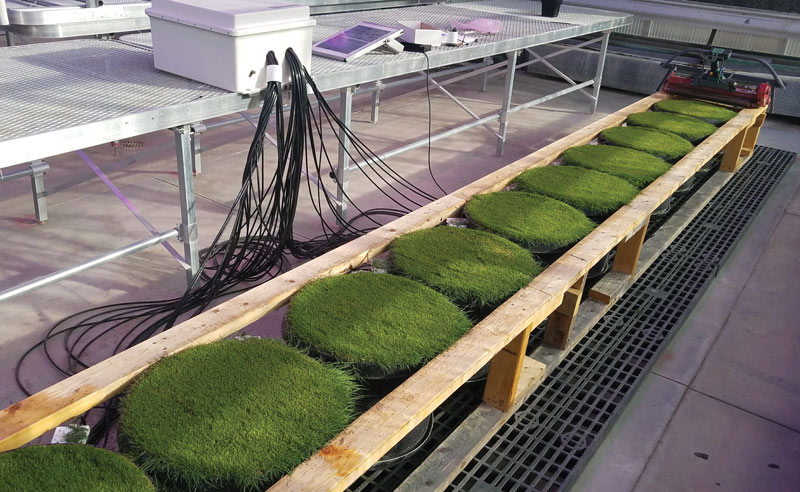
To test the efficacy of surfactants (wetting agents) in improving soil water retention and drainage, three products and an untreated control are being tested in lysimeters in a greenhouse at the University of Nebraska in Lincoln, Neb. Photo by Bill Kreuser
Surfactants (wetting agents) are frequently applied to sand-based turfgrass systems. Research at the University of Georgia, University of Arkansas, University of Wisconsin and New Mexico State University has demonstrated the importance of surfactant applications on sand-based turf for more than two decades. The benefits include increased infiltration rate, reduced localized dry spot, improved water retention or drying (depending on the degree of saturation), and lower wilting points.
Many of these research studies have also looked at the horizontal distribution of water with portable time-domain reflectometry (TDR) soil moisture probes. That work conclusively shows that surfactants can improve horizontal soil water distribution.
Recently, much of the surfactant discussion and marketing materials have shifted to the vertical distribution of water and the location of enhanced water retention or drainage. Some surfactants, marketed as “retainers,” are said to improve water retention and the vertical distribution of water in the soil. Other surfactants, marketed as “penetrants,” have properties that aid infiltration and drainage and that ultimately reduce water content within the soil. However, it is difficult for turfgrass scientists to measure these claims in the field.
The objectives of this research are to measure the vertical distribution of water in a sand-based profile treated with different types of surfactants, to relate surfactant concentrations in the soil to soil hydrophobicity and, ultimately, to create models to estimate soil surfactant longevity under different irrigation programs. This research will provide golf course superintendents greater control when designing and implementing a successful soil surfactant program. Ultimately, this will lead to higher irrigation efficiency, improved surface playability and enhanced turf health.
Experiments
This research is being conducted in 12 large lysimeters (pots) within a greenhouse at the University of Nebraska-Lincoln. The lysimeters are 17 inches (43 centimeters) in diameter and built to USGA recommendations for golf putting green construction. Each lysimeter has four 16-inch-long (41-centimeter-long) TDR probes inserted horizontally 1, 3, 7 and 11 inches (3, 8, 18 and 28 centimeters) below the surface.
We are evaluating a non-treated control and three different surfactants: Revolution and Dispatch from Aquatrols and an experimental product. Following application, the treatments are watered-in, and all the lysimeters receive different levels of irrigation, depending on the run. During the first run, irrigation was withheld until widespread wilt occurred. For the current run, irrigation is being applied to replace slightly more than evapotranspiration (or ET). The next run will feature significant leaching irrigation events. These runs will be replicated two or three more times during the next two years.
In addition to taking the soil moisture measurements from the embedded TDR probes, we are removing 0.75-inch (2-centimeter) cores weekly to measure hydrophobicity (from water-drop-penetration tests) and to measure the amount of surfactant in the soil. The hydrophobicity data will be correlated to soil surfactant concentrations, irrigation frequency, water content and soil temperature to create a crude model of surfactant degradation.
Future research
Over the past year, methodologies have been developed for extracting and modeling surfactant concentration within the soil using a mobile Fourier-transform infrared spectroscope (FTIR). We expect to have vertical water distribution profiles and soil hydrophobicity information from the three different irrigation runs by the end of 2019.
This research will help the turfgrass industry understand how different surfactants impact soil water content at various depths over time on a golf course. Our ultimate goal is to create models to help schedule surfactant applications, and to integrate those models into our decision-support tool, the GreenKeeper app.
Michael Carlson is a research technologist and a new doctoral student, Mark Keck is a graduate student pursuing a Master of Science degree, and Bill Kreuser is an assistant professor and Extension turfgrass specialist in the Department of Agronomy and Horticulture at the University of Nebraska, Lincoln, Neb.